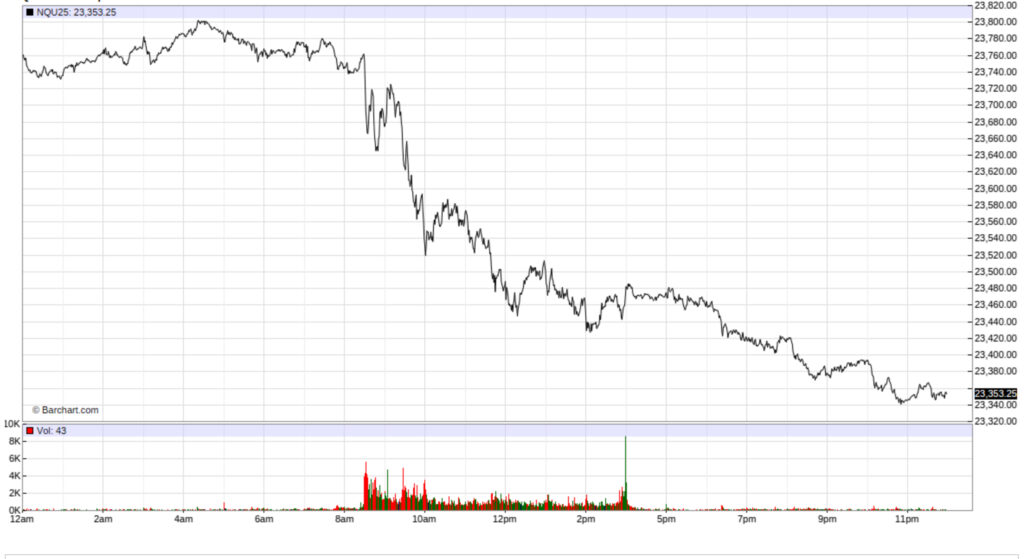Report Date: 2025-08-19
Estimated Price Ranges for 2025-08-19
| Metric | Price |
|---|---|
| Open | 23,797.75 |
| High | 23,942.00 |
| Low | 23,403.00 |
| Close | 23,376.25 |

Explanation of Price Movements
The Mini NASDAQ 100 futures experienced a notable decline on August 19, 2025, with contracts slipping 0.2% after a 1.4% drop, marking the second-worst decline since April’s tariff shock. This downturn was primarily driven by a significant sell-off in major technology and chipmaker shares, including a 3.5% slump in Nvidia Corp. and losses in AMD (nearly 5%) and Broadcom (4%), along with Palantir (over 9%). This indicates a “risk-off” sentiment and substantial profit-taking among traders following a robust 40% rally in the Nasdaq since April, coupled with concerns about stretched valuations (Nasdaq 100 trading at 27 times expected profits).
Geopolitical factors also contributed to market uncertainty. The looming threat of substantial tariffs on imported semiconductors from the Trump administration created ripples, negatively impacting some chip manufacturers while benefitting Intel due to reported investment prospects. Broader geopolitical tensions, such as a high-stakes meeting between President Donald Trump and President Vladimir Putin and ongoing discussions regarding a potential Ukraine peace deal, added to the cautious sentiment.
Expectations regarding Federal Reserve policy played a role, with investors keenly awaiting Chair Jerome Powell’s speech at the Jackson Hole symposium on Friday, August 22, 2025, for signals on interest rate cuts. While an 83% chance of a September rate cut is priced in, any wavering in these expectations could trigger further profit-taking, particularly in the tech sector, which is highly sensitive to borrowing costs. Additionally, rising bond yields, with the 10-year T-note reaching a 2-week high at 4.35% on August 18, 2025, pressured stock indexes, making fixed-income assets more attractive relative to equities.
Future Outlook
The outlook for Mini NASDAQ 100 futures remains cautious with a high degree of volatility expected in the near term. The market’s immediate focus will be on Federal Reserve Chair Jerome Powell’s speech at Jackson Hole later this week. Any deviation from the market’s current expectation of a September rate cut could lead to increased profit-taking and downward pressure, especially on growth-oriented technology stocks.
In the medium term, persistent geopolitical risks, particularly the potential for new tariffs on semiconductors, pose an ongoing threat to the technology sector and global supply chains. While company-specific earnings (like Palo Alto Networks’ strong guidance) can provide some support, the broader index’s movements will be heavily influenced by shifts in risk sentiment, monetary policy signals, and the overall economic landscape. The significant rally since April suggests that stretched valuations may continue to invite profit-taking episodes. The balance between underlying strong corporate fundamentals in large tech companies and macroeconomic headwinds will dictate the market’s direction.
Estimated Mini NASDAQ 100 Futures Prices (2025-08-19)
Latest Economic Data
| Indicator | Value | Date/Period |
|---|---|---|
| Treasury Bond Rates | ||
| US 10-Year Treasury Yield | 4.32% | August 20, 2025 |
| US 30-Year Bond Yield | 4.94% | August 18, 2025 |
| 4-Week Treasury Bill | 4.34% | August 19, 2025 |
| 8-Week Treasury Bill | 4.29% | August 19, 2025 |
| 13-Week Treasury Bill | 4.22% | August 19, 2025 |
| 17-Week Treasury Bill | 4.17% | August 19, 2025 |
| 26-Week Treasury Bill | 4.08% | August 19, 2025 |
| 52-Week Treasury Bill | 3.92% | August 19, 2025 |
| Gross Domestic Product (GDP) | ||
| Q2 2025 Real GDP Growth (Annualized) | 3.0% | Q2 2025 (Advance Estimate) |
| Q1 2025 Real GDP Growth (Annualized) | -0.5% | Q1 2025 (Third Estimate) |
| Q2 2025 Annual GDP Growth Rate | 2.0% | Q2 2025 |
| Current Nominal GDP | $30.33 Trillion | June 2025 |
Influence of Economic Factors on Price Movements
These key economic factors exert significant influence on the Mini NASDAQ 100 futures:
- Interest Rates and Treasury Bond Yields: Higher interest rates and bond yields generally exert downward pressure on stock indexes like the Nasdaq 100. When bond yields rise, as seen with the 10-year T-note yield increasing to 4.35% on August 18, 2025, lower-risk assets like Treasury bonds become more attractive, drawing investment away from higher-risk equities. For technology and growth stocks, which constitute a large portion of the Nasdaq 100, higher borrowing costs can limit future growth prospects and depress valuations. The Federal Reserve’s stance on maintaining or cutting rates (currently at 4.25%-4.50% with an 83% chance of a September cut) is a critical driver, with market expectations directly influencing price movements.
- Inflation: Inflation, even at moderate levels (2.7% annual in July 2025, core at 3.1%), can negatively impact corporate profit margins and consumer purchasing power, leading to reduced consumer spending. Rising prices for goods and services can hit company earnings, thereby affecting stock prices and investor confidence. The projection for headline and core CPI inflation to rise towards 3.1% and 3.3% respectively by December 2025 due to tariffs suggests continued inflationary pressure that could weigh on future market performance. Inflation also causes market volatility as investors seek sectors that can better withstand higher costs.
- Gross Domestic Product (GDP) Growth: GDP serves as a primary indicator of economic health. The rebound in Q2 2025 Real GDP growth to 3.0% (annualized) from a 0.5% contraction in Q1 2025 provides a positive signal for corporate earnings and overall economic stability. A growing economy generally supports higher stock prices as businesses see increased demand and profits. Conversely, any sustained slowdown or contraction, like that seen in Q1, can lead to decreased consumer and business spending, which typically drives equity markets lower. The growth in Q2 driven by consumer spending and decreased imports, despite reductions in investment and exports, indicates a mixed but resilient economic picture.
- Unemployment: The stock market is highly sensitive to employment data because it reflects consumer spending capacity, a major driver of the US economy. While low unemployment (4.2% in July 2025) generally signals robust consumer spending and economic growth, a surprisingly higher-than-expected unemployment rate can sometimes lead to an increase in stock prices. This counterintuitive effect occurs because a weaker labor market might prompt the Federal Reserve to adopt looser monetary policies (e.g., lower interest rates) to stimulate the economy, thereby driving investment into higher-risk assets like stocks. The noted slowdown in the labor market in H1 2025, with job revisions and a slight increase in unemployment, suggests conditions that could prompt such Fed consideration

